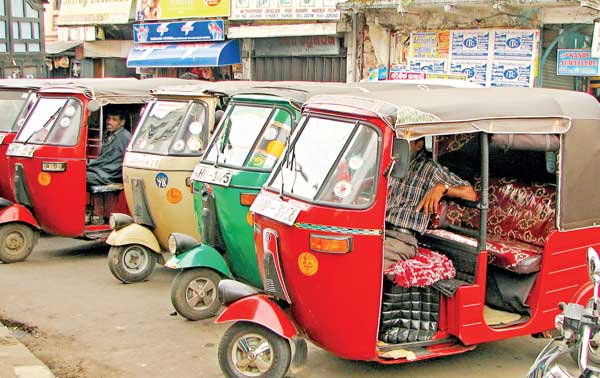14 Dec 2016 - {{hitsCtrl.values.hits}}
 As most instances, the only available employment falls in the category of day labour. Most of the youth want something better than that. Due to this, most young people get attracted to own or hire three-wheelers to make a living. There are roughly 1.059 million three-wheelers registered with the Registrar of Motor Vehicles (RMV). A three-wheeler requires at least one driver.
As most instances, the only available employment falls in the category of day labour. Most of the youth want something better than that. Due to this, most young people get attracted to own or hire three-wheelers to make a living. There are roughly 1.059 million three-wheelers registered with the Registrar of Motor Vehicles (RMV). A three-wheeler requires at least one driver.
 It has been eight years since Sri Lanka’s brutal three-decade-long civil conflict came to an end in May 2009, but for the country’s youth, the true peace dividend is still a long way off. They blame a lack of understanding and the older generation’s unwillingness to compromise for the on-going economic divisions in this country, where years of ethnic strife created a culture of discord that was not defeated on the battlefield.
It has been eight years since Sri Lanka’s brutal three-decade-long civil conflict came to an end in May 2009, but for the country’s youth, the true peace dividend is still a long way off. They blame a lack of understanding and the older generation’s unwillingness to compromise for the on-going economic divisions in this country, where years of ethnic strife created a culture of discord that was not defeated on the battlefield.
Youth activists and government officials have voiced a unanimous appeal to Sri Lanka’s national leaders to listen to the roughly five million citizens between the ages of 15 and 25, who will determine the country’s future. If these young people are marginalized, sustainable economic growth will be virtually impossible. Today, despite all the promises, many graduates and other educated youth in the rural areas remain unemployed. As a result, they get jobs below their qualifications outside the province.
As most instances, the only available employment falls in the category of day labour. Most of the youth want something better than that. Due to this, most young people get attracted to own or hire three-wheelers to make a living. There are roughly 1.059 million three-wheelers registered with the Registrar of Motor Vehicles (RMV). A three-wheeler requires at least one driver.
Out of the 7.8 million employed population, 1.2 million people are estimated to be three-wheeler drivers. This is a staggering 15.4 percent of the working population. As a result, today many sectors of the economy are starved of critical manpower. We need to find a way to move them into better-paying, low-stressed productive jobs, in order to fill the acute manpower gaps in industry and also strengthen the talent pipeline in the manufacturing, construction, tourism and services sectors.
Current situation
a) The three-wheeler drivers virtually have no future and their expectations of improving their standard of living is totally dependent entirely on the income derived from driving three-wheelers for hire.
b) They spend a large portion of their time waiting for a customer on the road.
c) Their age distribution shows that many of them are below 38 years. The number of drivers below 28 years of age is over 28 percent and those below 38 years of age are over 67 percent. Many of them have either passed the O/Ls or A/Ls or are graduates.
d) There are many other factors such as many of them being underemployed and also involved in frequent road accidents.
e) the youth who are passing out from secondary education are immediately attracted to work as three-wheeler drivers due to limited employment opportunities, very low entry barriers and the opportunity to be self-employed.
f) The annual average increase of three-wheelers into the market is around 14 percent. This creates many opportunities annually for young people who cannot find gainful work to join this industry.
Expectations
To address this issue, the government needs a strategy to provide a platform for the current three-wheeler drivers to engage in productive work that can deliver better income, in line with their future aspirations. The strategy would be to engage potential new entrants, as well as those who are in their early stage of their career to join new fields, which require training and retraining.
The strategy requires the setting up of new programmes that can set them up for industry and at hours convenient for them, given their working patterns. The objective of this strategy of creating better livelihoods needs to be conveyed to them through print and electronic media, where the target audience will have regular access. This effort would require coordinated action from the vocational training authorities, chambers and the private sector. Further, labour market reforms are required for the creation of an enabling environment, which will cater for new types of job/work opportunities.
The challenge
Three-wheelers are one of the vital means for low-cost transportation in Sri Lanka. It serves as a family vehicle and during heavy traffic, it is usually used as a quick means to get to places. Further, it is also used for transportation in underserved rural areas; it generates a substantive income for the leasing and lending institutions and provides livelihoods for people in the repairs and maintenance sectors. Therefore, the efforts should be well balanced, particularly in view of the public transportation gap, which is likely to create.
Practically, no vehicle should be rendered redundant due to the exit of a driver. Their places would be taken by new entrants. As a solution, the new entrants like in Singapore must be retirees from other sectors particularly from the government and private sectors. In Sri Lanka, we are experiencing an aging population. There’ll be more people over 40 years of age in the next 10 to 15 years. Importantly, the growth of three-wheelers in Sri Lanka must be checked with the entry of smaller four-wheel vehicles.
Conclusion
In the final analysis, we need to redeploy those below 30, who are underemployed and trainable, into industry to fill the manpower gaps in industry and also set in motion a process to manage the entry of people below the age of 30.
This effort to succeed would require the collaboration and cooperation between all the key stakeholders and also a transformational leader to provide leadership. In addition, the companies (importers of the three-wheelers and the leasing companies) that have minted money from these young people, should invest in a training facility to develop skills.
(Dinesh Weerakkody is an
HR thought leader)
10 Jan 2025 19 minute ago
10 Jan 2025 36 minute ago
10 Jan 2025 56 minute ago
10 Jan 2025 2 hours ago
10 Jan 2025 2 hours ago